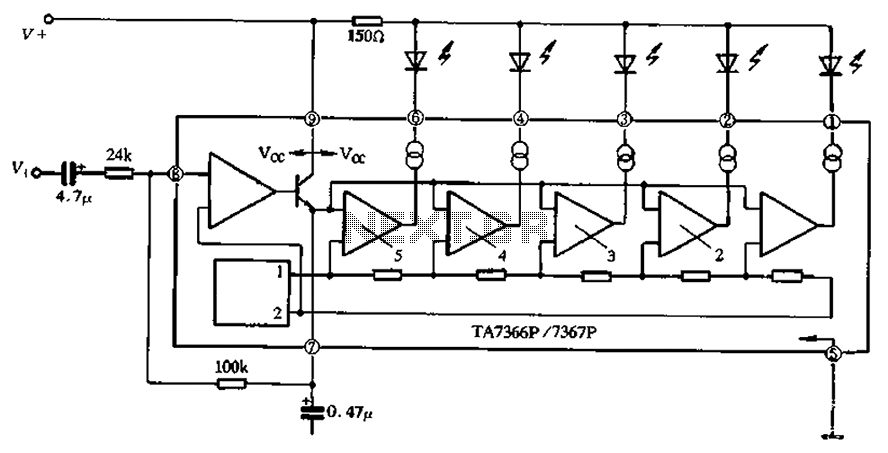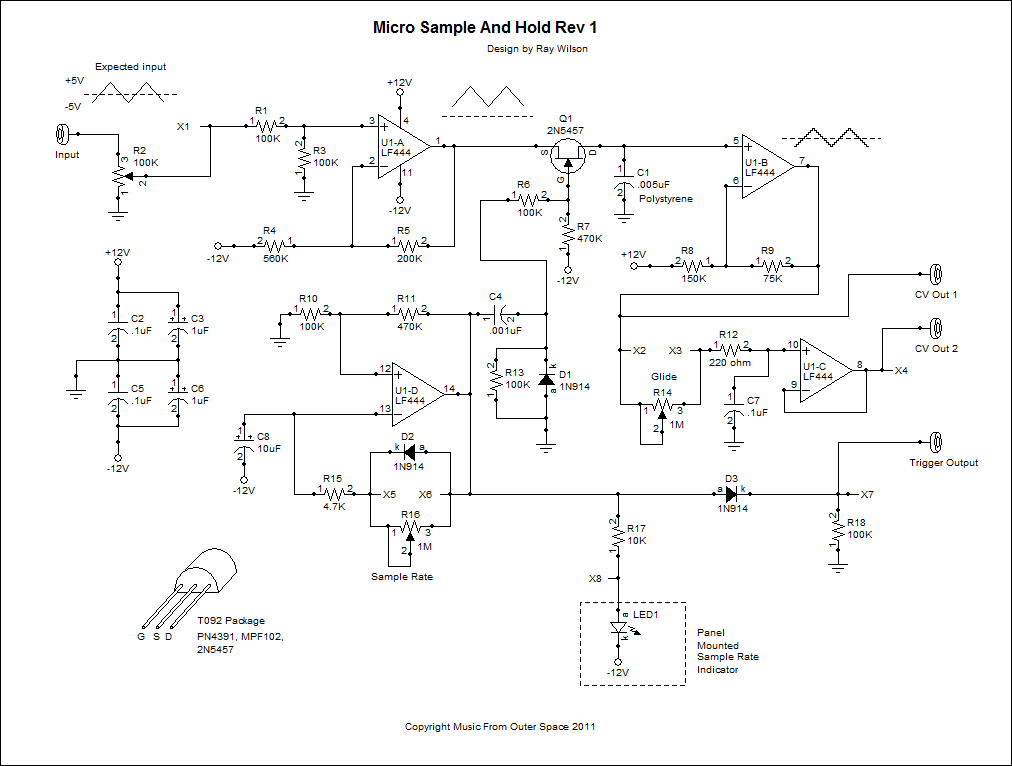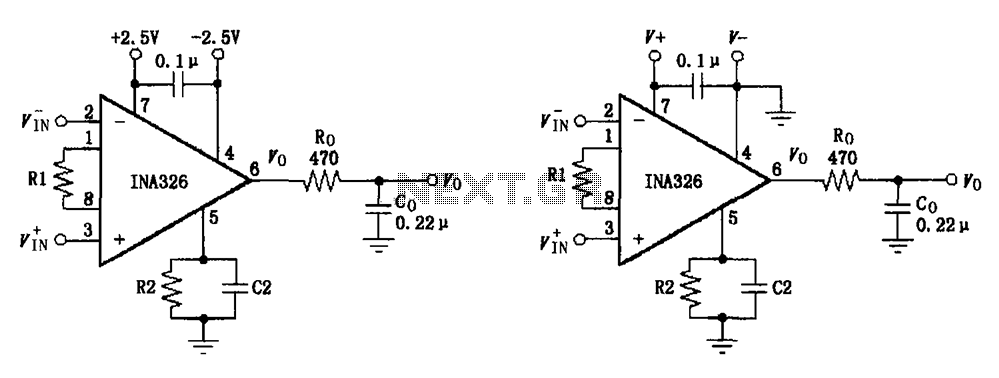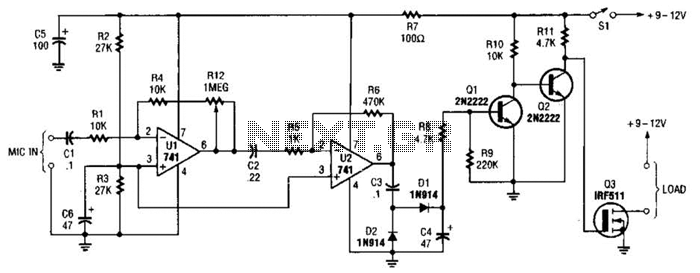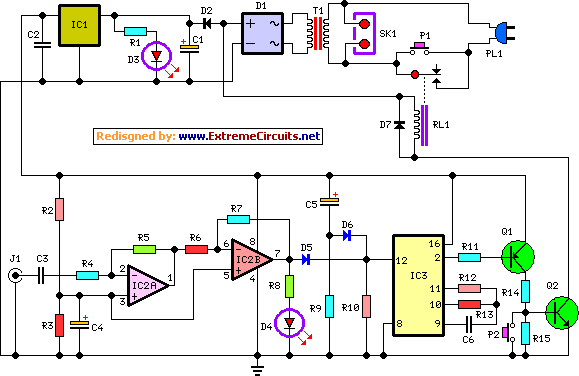
Automatic Water Tank FillerCircuit Circuit
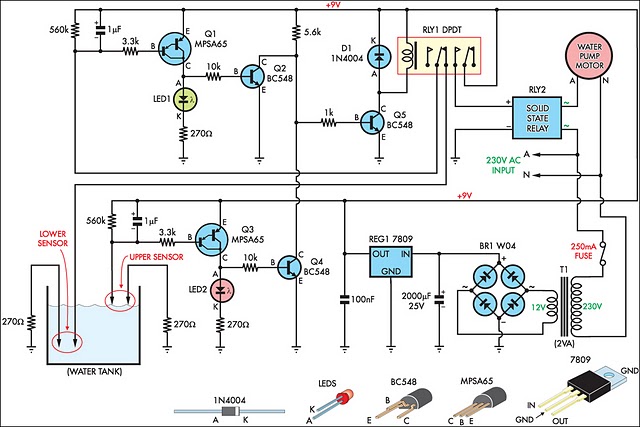
This circuit is designed to efficiently fill a header tank for a reticulated water supply on a farm. It supplies eight troughs located in various paddocks where water scarcity can have severe consequences for livestock. Previously, the tank was filled daily using a time clock, which proved ineffective. During hot weather, the livestock would deplete the tank regularly, leaving them without water for several hours. Conversely, during wet weather, the tank would overflow if the cattle did not consume much water. The described circuit maintains the water level in the header tank within specified limits. It controls a 3HP submersible bore pump that requires a solid-state relay capable of handling its high starting current. Two Darlington transistors, Q1 and Q3, work in conjunction with Q2 and Q4, which are connected to the upper and lower water sensors in the tank. Q2 and Q4 share a common 5.6 kΩ load resistor and function as a NOR gate. The output from the NOR gate activates Q5, which, in turn, engages relay RLY1. When the water level is low, both sensors are open-circuit, resulting in a high output from the NOR gate that energizes the relay. This action opens the normally closed (NC) contacts of the relay, disconnecting the lower sensor while the upper sensor remains open-circuit, keeping the relay energized. The normally open (NO) contact of the relay closes to operate the solid-state relay RLY2, activating the pump. This state persists until the water level reaches the upper sensor, at which point the NOR gate output drops to 0V, deactivating relay RLY1 and stopping the pump. In practice, the upper sensor is positioned just below the tank's overflow, while the lower sensor is located about halfway up the tank. The sensor contacts consist of two stainless steel screws approximately 25 mm apart, mounted through the poly tank walls. The wiring junctions on the tank's side are sealed with neutral-cure silicone sealant for protection.
The circuit utilizes a combination of sensors and transistors to create an automated water level control system that enhances the reliability of water supply for livestock. The use of Darlington transistors allows for high current amplification, ensuring that the control signals can effectively manage the operation of the pump. The NOR gate configuration enables a simple yet effective logic operation, where the output only activates the pump when both sensors indicate a low water level.
The relay system provides a robust method for isolating the control circuit from the high-power components, such as the submersible pump. This isolation is crucial for protecting sensitive electronic components from voltage spikes and current surges that occur during the pump's operation. The solid-state relay (RLY2) is particularly well-suited for this application due to its ability to handle the inductive load of the pump without mechanical wear, thereby enhancing the longevity and reliability of the system.
The placement of the sensors is strategically designed to prevent overflow and ensure that the tank is adequately filled before reaching critical low levels. The use of stainless steel screws as sensor contacts offers durability and resistance to corrosion, which is essential in a water application. Furthermore, the sealing of wiring junctions with silicone sealant prevents moisture ingress, contributing to the overall reliability of the circuit in outdoor conditions.
Overall, this circuit design exemplifies an effective solution for maintaining water supply in agricultural settings, addressing the challenges posed by variable weather conditions and livestock demands.This circuit has been very useful in filling a header tank for a reticulated water supply on a farm. Eight troughs are supplied in different paddocks where a lack of water would have serious consequences for the stock. In the past, the tank had been filled daily by a time clock which was not successful. During hot weather, the stock would empty th e tank on a regular basis and then be without water for several hours or the tank would overflow and flood the area if the weather was wet and the cattle did not drink much. The circuit described has been used to maintain the level of water in the header tank within prescribed limits.
It controls a 3HP submersible bore pump which has a high starting current, necessitating a solid-state relay sufficient to take the starting load. Two Darlington transistors, Q1 & Q3, in conjunction with Q2 & Q4, are connected to the upper and lower water sensors in the tank.
Q2 & Q4 have a common 5. 6kO load resistor and function as a NOR gate. The output of the NOR gate drives Q5 which activates relay RLY1. Initially, when the water level is low, both sensors will be open-circuit, the NOR gate output will be high and the relay will be turned on. This causes the normally closed (NC) contacts of the relay to open and disconnect the lower sensor. However, the upper sensor will still be open circuit and the NOR gate output will be high, keeping the relay closed.
The normally open (NO) contact of the relay will be closed to operate the solid-state relay RLY2 to run the pump. This state continues until the water reaches the top sensor which will then drop the output from the NOR gate to 0V.
The disables relay RLY1 and the pump is stopped. In practice the upper level sensor is just below the overflow from the tank and the lower sensor about half way up the tank. The sensor contacts are simply two stainless steel screws about 25mm apart and screwed through the poly tank walls.
The wiring junctions on the side of the tank are protected by neutral-cure silicone sealant. 🔗 External reference
The circuit utilizes a combination of sensors and transistors to create an automated water level control system that enhances the reliability of water supply for livestock. The use of Darlington transistors allows for high current amplification, ensuring that the control signals can effectively manage the operation of the pump. The NOR gate configuration enables a simple yet effective logic operation, where the output only activates the pump when both sensors indicate a low water level.
The relay system provides a robust method for isolating the control circuit from the high-power components, such as the submersible pump. This isolation is crucial for protecting sensitive electronic components from voltage spikes and current surges that occur during the pump's operation. The solid-state relay (RLY2) is particularly well-suited for this application due to its ability to handle the inductive load of the pump without mechanical wear, thereby enhancing the longevity and reliability of the system.
The placement of the sensors is strategically designed to prevent overflow and ensure that the tank is adequately filled before reaching critical low levels. The use of stainless steel screws as sensor contacts offers durability and resistance to corrosion, which is essential in a water application. Furthermore, the sealing of wiring junctions with silicone sealant prevents moisture ingress, contributing to the overall reliability of the circuit in outdoor conditions.
Overall, this circuit design exemplifies an effective solution for maintaining water supply in agricultural settings, addressing the challenges posed by variable weather conditions and livestock demands.This circuit has been very useful in filling a header tank for a reticulated water supply on a farm. Eight troughs are supplied in different paddocks where a lack of water would have serious consequences for the stock. In the past, the tank had been filled daily by a time clock which was not successful. During hot weather, the stock would empty th e tank on a regular basis and then be without water for several hours or the tank would overflow and flood the area if the weather was wet and the cattle did not drink much. The circuit described has been used to maintain the level of water in the header tank within prescribed limits.
It controls a 3HP submersible bore pump which has a high starting current, necessitating a solid-state relay sufficient to take the starting load. Two Darlington transistors, Q1 & Q3, in conjunction with Q2 & Q4, are connected to the upper and lower water sensors in the tank.
Q2 & Q4 have a common 5. 6kO load resistor and function as a NOR gate. The output of the NOR gate drives Q5 which activates relay RLY1. Initially, when the water level is low, both sensors will be open-circuit, the NOR gate output will be high and the relay will be turned on. This causes the normally closed (NC) contacts of the relay to open and disconnect the lower sensor. However, the upper sensor will still be open circuit and the NOR gate output will be high, keeping the relay closed.
The normally open (NO) contact of the relay will be closed to operate the solid-state relay RLY2 to run the pump. This state continues until the water reaches the top sensor which will then drop the output from the NOR gate to 0V.
The disables relay RLY1 and the pump is stopped. In practice the upper level sensor is just below the overflow from the tank and the lower sensor about half way up the tank. The sensor contacts are simply two stainless steel screws about 25mm apart and screwed through the poly tank walls.
The wiring junctions on the side of the tank are protected by neutral-cure silicone sealant. 🔗 External reference
Warning: include(partials/cookie-banner.php): Failed to open stream: Permission denied in /var/www/html/nextgr/view-circuit.php on line 713
Warning: include(): Failed opening 'partials/cookie-banner.php' for inclusion (include_path='.:/usr/share/php') in /var/www/html/nextgr/view-circuit.php on line 713
